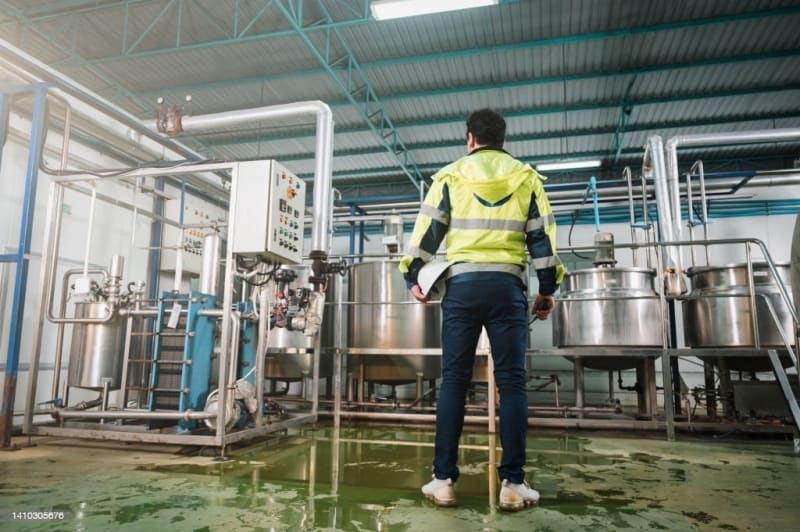In industrial environments like manufacturing units, chemical plants, and warehouses, spills and leaks present a pressing concern. Beyond the immediate danger to employee well-being, these incidents threaten the environment and the very foundation of a business.
Exposure to harmful substances can lead to severe health issues ranging from respiratory distress and skin reactions to neurological disorders, cancer, and reproductive complications. Ecologically, unintended discharges can disrupt aquatic ecosystems, harm terrestrial wildlife, and create long-term environmental degradation affecting humans.
On the business front, the ripple effects of a spill or leak can erode profitability through inventory loss, structural damage, and machinery malfunctions. These incidents necessitate expensive remediation efforts. As such, swift detection and action are paramount to mitigate these risks and safeguard all stakeholders
But relying on manual inspection, a standard practice for spill and leak detection in the industry, may not be a feasible option for large facilities. Not only is manual inspection time-consuming and labor-intensive, but it is also prone to overheads and errors. This makes real-time Vision AI detection a great choice against spills and leak hazards.
What is Vision AI?
Vision AI, also known as computer vision, is a field of artificial intelligence (AI) that enables computers to derive meaningful information from digital images, videos, and other visual inputs. It can then be tasked to make informed decisions based on what they see.
When paired with surveillance cameras and IR sensors, Vision AI models glean visual data from factories and their environments. Through a technique known as inferencing, these models discern patterns, shapes, and hues, and can be programmed to pinpoint irregularities such as spills or leaks.
Knowing more about Vision AI Algorithms that help detect hazards such as spills and leaks in real-time
Object Detection
Object detection algorithms identify and locate objects, such as containers or pipes, that might be susceptible to chemical leaks. These algorithms first identify the objects in an image or video and then look for specific features indicative of a leak, such as a change in the shape or color of the object or the presence of a liquid puddle.
Anomaly Detection
Anomaly detection algorithms compare current images to a baseline to spot any unusual visual patterns that may indicate a spill or leak. These algorithms typically work by first creating a baseline image or video of the area that is being monitored. Once the baseline image or video has been created, the algorithm can compare subsequent images or videos to the baseline. If any unusual patterns are detected, the algorithm can alert the user.
*Semantic Segmentation *
Semantic segmentation algorithms analyze images pixel by pixel, distinguishing between different substances or materials, even in complex scenarios. These algorithms identify the presence of a chemical spill or leak by identifying the different materials in the image or video. For example, a semantic segmentation algorithm could be used to identify the presence of a liquid puddle and then determine whether the liquid puddle is made up of a hazardous chemical.
These are just a few of the Vision AI algorithms that can be used to detect chemical spills and leaks. Which specific algorithm will be required to detect spills and leaks will depend on the application and the environment in which the detection solution has to be deployed.
Spills and Leak Detection Use Cases
Let’s have a closer look at the industries where Vision AI can be leveraged for prompt detection of spills and leaks.
Oil and Gas Fields
Spills and leaks can occur during drilling, production, transportation, and storage processes in oil and gas fields. Vision AI systems can be deployed to monitor vast areas and detect any leakage or spillage of oil or gas. These systems use high-resolution cameras and image processing algorithms to analyze images and identify any environmental anomalies or changes continuously. For instance, if there is an unexpected presence of an oil sheen on water or a gas plume in the vicinity, the Vision AI system can immediately alert operators and supervisors who can shut down the operation to prevent further damage or accidents.
Shipping Industry
The shipping industry deals with hazardous materials and containers, making monitoring for spills and leaks extremely crucial. Vision AI technologies can be employed to analyze video feeds from ship decks, cargo storage areas, and even port facilities, detecting any spills or potential leakages. Vision AI models can identify unusual substances, flow patterns, and leakage points by analyzing video streams in real time. Automated alerts can then be generated to ensure timely response, preventing any environmental contamination or safety risks.
Chemical Plants
Chemical plants handle various hazardous substances, and spills or leaks can have severe consequences. Vision AI systems in chemical plants use cameras and thermal/IR sensors to monitor critical areas continuously. These systems employ machine learning algorithms to analyze the visual data and detect any signs of leakage, such as unusual vapors or chemical flows. Immediate alerts can be sent to plant operators or safety personnel, enabling them to take corrective actions before significant damage occurs.
Manufacturing Facilities
Manufacturing facilities often deal with various liquids, including coolant fluids, oils, or chemical solvents. Vision AI can monitor production lines and storage areas for spills or leaks. Cameras equipped with thermal imaging or hyperspectral capabilities can identify temperature variations, detect leaks by recognizing dripping fluids, or assess the composition of substances. By integrating these visual analysis capabilities into control systems, manufacturers can quickly detect and address spills or leaks, preventing downtime, product contamination, or environmental hazards.
Food Processing Facilities
Food processing facilities handle liquids, oils, and chemicals necessary for cleaning, sanitization, and production. Vision AI can monitor critical areas, equipment, and pipelines for any potential leaks or spills. By analyzing camera footage, Vision AI algorithms can detect changes in color, texture, or flow indicative of leaks or spills. Timely detection and response can help prevent contamination of food products, maintain hygiene standards, and ensure consumer safety.
Here are just a handful of the myriad applications for leak detection that Vision AI offers. As the technology evolves, we anticipate an influx of even more pioneering and transformative uses of Vision AI in the realm of spill and leak detection.
Ready to Embrace Vision AI?
For ages, the go-to method for detecting spills and leaks has been manual inspection and maintenance. However, these methods can be laborious, time-intensive, and occasionally fall short in accuracy. In contrast, Vision AI offers a proactive and precise approach, detecting chemical spills and leaks without the need for human intervention. With its ability to detect and alert about potential issues early on, this technology is poised to significantly reduce environmental and health hazards associated with such incidents. Dive deeper into how Vision AI for Spills and Leak Detection can revolutionize your industry by exploring our resources here











Top comments (0)